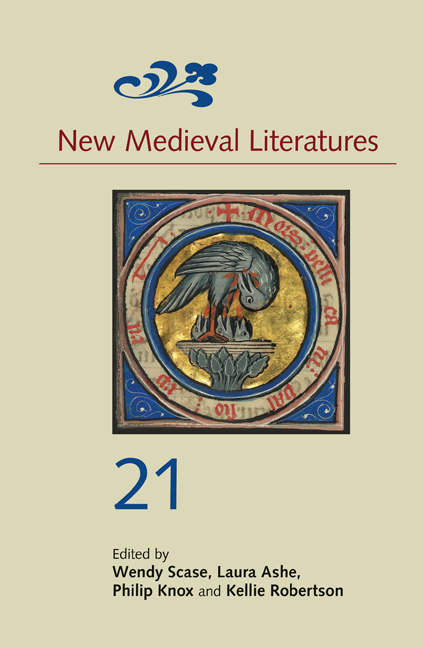Book contents
- Frontmatter
- Contents
- List of Illustrations
- List of Abbreviations
- 1 ‘Chevaliers estre deüsiez’: Genealogy and Historical Sense in Chrétien de Troyes’s Conte du Graal
- 2 English Vernacular Script in the Thirteenth Century (c.1175–c.1325)
- 3 The Manuscript as Agent: The Politics of London, British Library, Additional MS 15268 (Histoire ancienne jusqu’à César)
- 4 Repetition, Craft-Knowledge, and Richard Rolle’s Creaturely Sublime
- 5 Truth-Telling and Truthiness in the Middle English Popular Romances
- 6 Assaying the Deer Drive in Sir Gawain and the Green Knight
- 7 The Past of the Past: Historical Distance and the Medieval Image
6 - Assaying the Deer Drive in Sir Gawain and the Green Knight
Published online by Cambridge University Press: 13 April 2021
- Frontmatter
- Contents
- List of Illustrations
- List of Abbreviations
- 1 ‘Chevaliers estre deüsiez’: Genealogy and Historical Sense in Chrétien de Troyes’s Conte du Graal
- 2 English Vernacular Script in the Thirteenth Century (c.1175–c.1325)
- 3 The Manuscript as Agent: The Politics of London, British Library, Additional MS 15268 (Histoire ancienne jusqu’à César)
- 4 Repetition, Craft-Knowledge, and Richard Rolle’s Creaturely Sublime
- 5 Truth-Telling and Truthiness in the Middle English Popular Romances
- 6 Assaying the Deer Drive in Sir Gawain and the Green Knight
- 7 The Past of the Past: Historical Distance and the Medieval Image
Summary
Introduction
Slain bodies of female deer pile up at the end of the first hunt scene in Sir Gawain and the Green Knight, laid out in such numbers as ‘to deme were wonder’. The huntsmen separate a deer's head and neck from its body, cut the sides off the backbone, and toss the pelvic bone into the woods. They pierce both sides and hang the halves off the deer's legs by its hocks. These are the final stages in breaking the deer, followed by the curée – the ritual rewarding of the hounds with fresh offal laid out on the hide of the dead animal. The ‘best’ of the hunters have their choice of the best deer and assess the bodies accordingly:
Gedered þe grattest of gres þat þer were
And didden hem derely vndo as þe dede askez.
Serched hem at þe asay summe þat þer were;
Two fyngeres þay fonde of þe fowlest of alle.
(SGGK, lines 1326–29)The men of greatest nobility pick the carcasses with the greatest amount of fat – the bounty of Sir Bertilak de Hautdesert's deer park, as shown by the quality of the deer themselves, results in the leanest deer possessing several inches of luxurious ‘gres’. The stacks of animal bodies, the scores of hunters and attendants, and the fat lining even the smallest deer contribute to an event marked by material excess and natural abundance.
Sir Gawain and the Green Knight combines aspects of both early English and Norman hunting methods into the hybridized event of the deer drive. The enclosed hunting parks of pre-Conquest England become the specified deer parks of Norman import, where native and non-native species of deer coexisted as objects of different kinds of pursuit. But when both Norman and early English hunting practices are combined in the deer drive of Sir Gawain, the differing scale – one with a glut of carcasses, the other designed for a single kill – results in a surplus of material. The controlled rituals of the Norman hunt à force cannot fully contain the excesses of the early English drive hunt, whose success is measured by the number of bodies collected at the end of the event.
- Type
- Chapter
- Information
- New Medieval Literatures 21 , pp. 172 - 190Publisher: Boydell & BrewerPrint publication year: 2021



